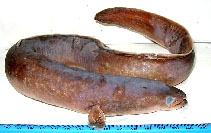| Family: | Anguillidae (Freshwater eels) | picture (Anben_u2.jpg) by Devarapalli, P.  | ||
| Order: | Anguilliformes (eels and morays) | |||
| Class: | Actinopterygii (ray-finned fishes) | |||
| FishBase name: | Indian mottled eel | |||
| Max. size: | 120 cm TL (male/unsexed; Ref. 4832); max. published weight: 6,000 g (Ref. 1479) | |||
| Environment: | benthopelagic; catadromous | |||
| Climate: | tropical; 23°N - 33°S | |||
| Global Importance: | fisheries: commercial; aquaculture: commercial | |||
| Resilience: | Very low, minimum population doubling time more than 14 years (Preliminary K or Fecundity.) | |||
| Distribution: | Asia: Pakistan, India, Sri Lanka, Burma, and the East Indies. Reported from Nepal (Ref. 9496, 12045) and Bangladesh (Ref. 1479). Endangered status in India (Ref. 44150). Anguilla bengalensis labiata is the African subspecies (Ref. 3971). | |||
| Diagnosis: | Dorsal soft rays (total): 250-305; Anal soft rays: 220-250; Vertebrae: 106-112. Body elongate, head conical, flattened dorsally. Mouth terminal, lips prominent, narrow bands of teeth on jaws, broad band on vomer. | |||
| Biology: | Lives in freshwaters, but also occurs in estuaries and in the sea during early life and near maturity (Ref. 4832). Occurs in freshwater streams, pools and reservoirs and commonly found in mud substrates of tanks and in deep rock pools of rivers (Ref. 41236). Most common eel in Indian inland waters. There exists a good export market for both live elvers and eels. Highly prized as food fish because of its nutritional value. Fish mucous from live fish mixed with rice or wheat flour is used as medicine for arthritis (Ref. 44150) | |||
| Threatened: | Not Evaluated, see IUCN Red List , (Ref. 36508) | |||
| Dangerous: | harmless | |||
| Coordinator: | | |||
Thursday, April 1, 2010
Anguilla bengalensis bengalens - (Vallangoo)
Subscribe to:
Post Comments (Atom)
No comments:
Post a Comment